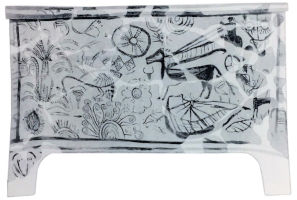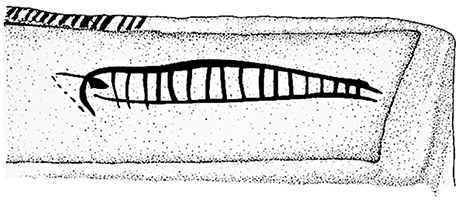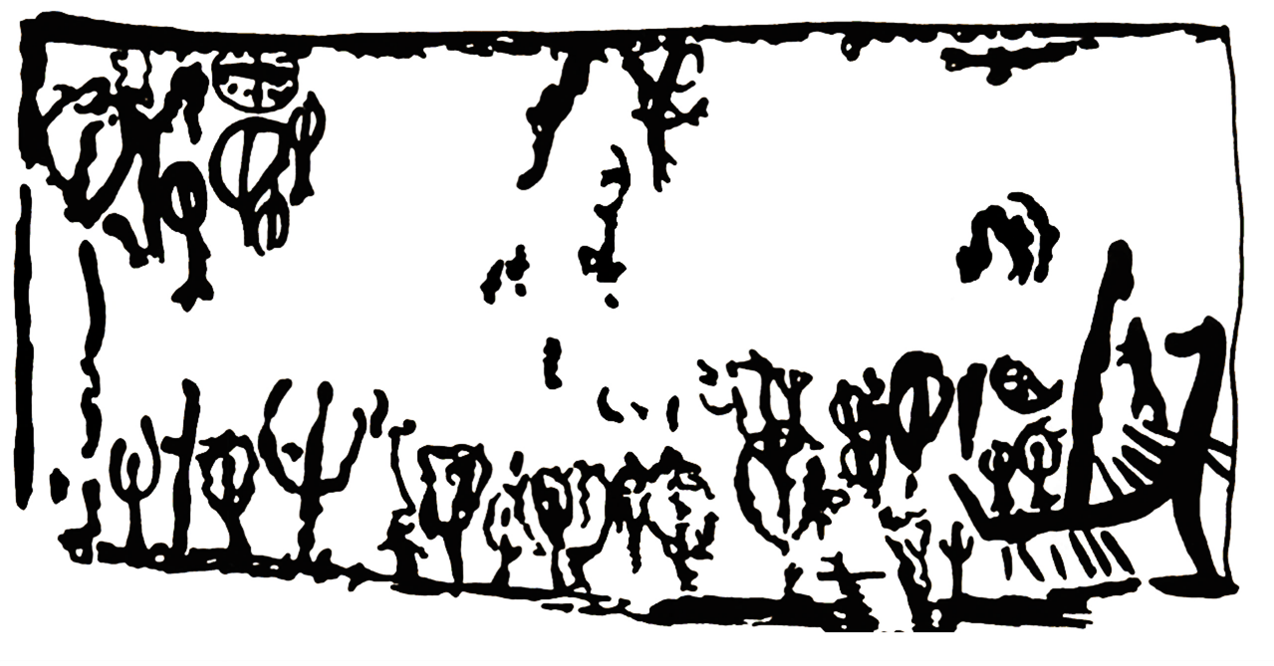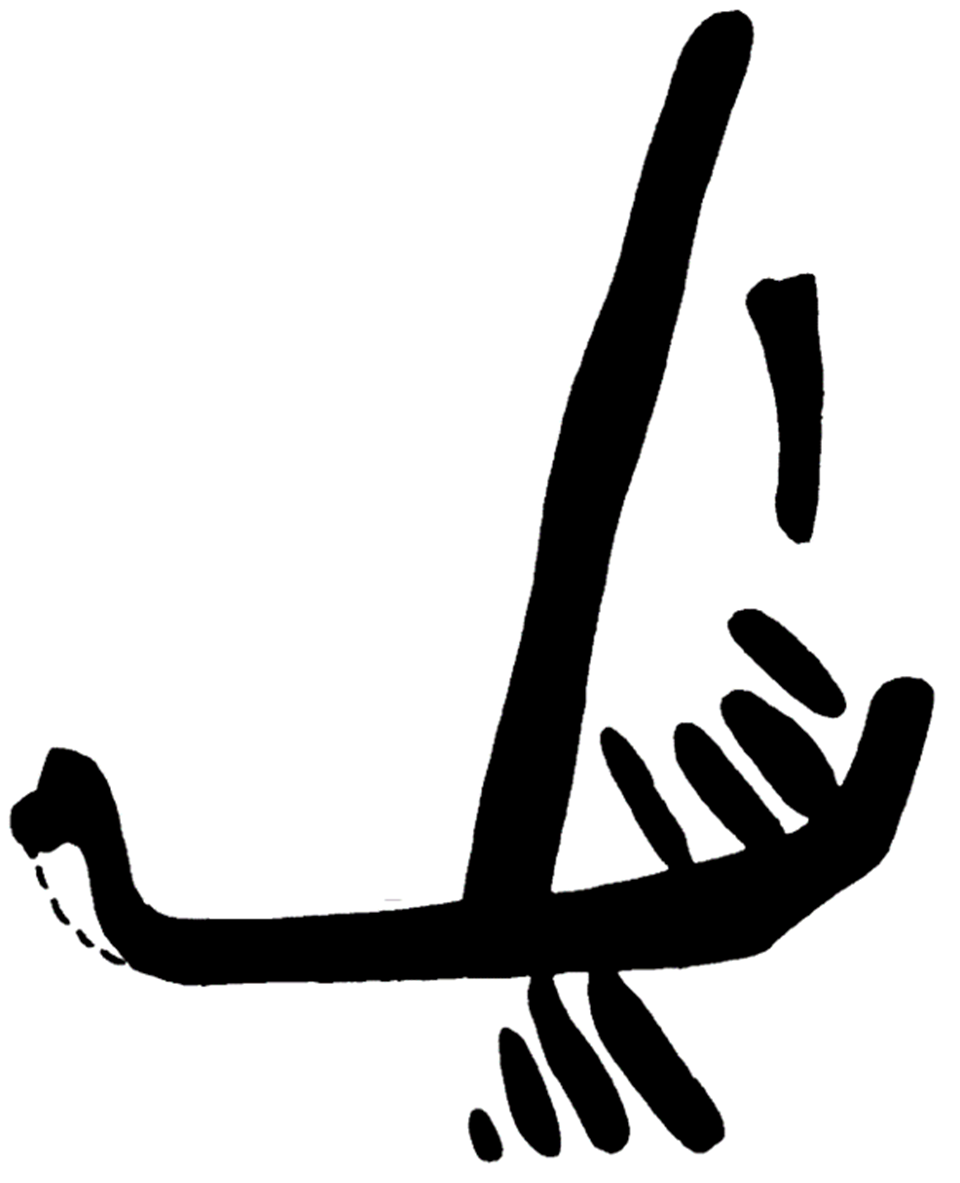The ship is located in the lower right corner on one of the large sides. Ship to the left (?) with a flat hull. The left post rises abruptly and is near vertical, probably the stempost. The right post curves upwards more smoothly. Near the right extremity of the vessel inside the hull are four oblique parallel lines. Four additional oblique parallel lines below the hull amidships are probably the oars. Thick oblique line at the center of the ship is likely the mast.
Helladic galley
A81
LH IIIA-B
Tanagra, tomb 47
n/a
Clay larnax
Thebes Archaeological Museum
Cavanagh and Mee 1995: 61, no. 47; Gallou 2005: 46, 200, fig. 35; Immerwahr 1998: 116-117, fig. 7.7; Kramer-Hajos 2015: 633, table 1, no. 41, 635; Spyropoulos 1973b: 21, pl. 10:a; 1973c: pl. 221:c; Wedde 2000: 330, no. 697
Located about 20 km east of Thebes, Tanagra is unique on the Mycenaean mainland for its widespread use of larnakes for burials. The two cemeteries at Dendron and Gephyra have provided over 60 larnakes from official excavations, as well as another 18 which were illegally excavated. Overall, many are unprovenanced while the rest have been published only in brief preliminary reports. The contexts of the larnakes are thus either unknown or slim on the details. The Dendron cemetery appears to span in use from LH IIA to LH IIIB, with most pottery dating to LH IIIA2-LH IIIB. The Gephyra cemetery in turn was in use from LH IIIA to LH IIIC early, with most pottery dating to LH IIIB. The earlier tombs rarely include larnakes, with most of the related pottery and larnakes themselves pointing to a date between LH IIIA2-LH IIIB - a period of about 150 years.
Most tombs did not contain larnakes (Dendron: 18/137; Gephyra: 17/73), and they usually occur alongside with regular inhumations within the same tombs. They occur in both smaller more modest tombs as well as in richer ones, yet rich tombs did not necessarily have them, suggesting that they were not strictly linked to wealth or status. Kramer-Hajos concludes that the larnax burial was neither an exclusive not a majority rite at the site (Kramer-Hajos 2015). Finally, a good number of the larnakes were undecorated while those with decoration are only adorned on their exterior, hinting that they were intended to be viewed by the living. Mourning women are by far the most commonly depicted scene, while the rest show other aspects of the mortuary ritual (processions, prothesis scenes, funeral games). On average, the Tanagra larnakes are smaller than Cretan ones, ranging between 0.6-0.8 m in length. They appear to have been used as primary burial containers rather than as ossuaries, as evidenced by the fact that some contained single skeletons and well as the presence of drainage holes on the larnakes. The choice of subject matter and the style of drawing is so different from contemporary Cretan larnakes that direct links are unlikely.
The scene has been tentatively read as depicting the underworld, a Mycenaean precursor of the later Greek stories about Charron. The composition appears somewhat chaotic, filled with amorphous forms which are interpreted as either trees/plants or possibly "shades" which recall the phi and psi figurines. Two such symbols appear in the left-side of the hull but should be read as part of the background rather than an element of the ship itself. The placement of the ship in the corner facing towards the stretch of scenery reinforces the impression of a journey. Wedde has drawn the lefthand post with an outward-pointing figurehead, but the poor preservation of the paint and its flakiness makes this reading not entirely secure.
Cavanagh, W., and Mee. C. 1995. “Mourning before and after the Dark Age,” in C. Morris (ed.) Klados: Essays in Honour of J. N. Coldstream (BICS Suppl. 63). London: University of London, Institute of Classical Studies, pp. 45–61.
Gallou, C. 2005. The Mycenaean Cult of the Dead (BAR-IS 1372). Oxford: Archaeopress.
Immerwahr, S. 1998. “Death and the Tanagra Larnakes,” in J. B. Carter and S.P. Morris (eds.), The Ages of Homer: A Tribute to Emily Townsend Vermeule. Austin: University of Texas Press, pp. 109-122.
Kramer-Hajos, M. 2015. “Mourning on the Larnakes at Tanaga: Gender and Agency in Late Bronze Age Greece,” Hesperia 84: 627-667.
Spyropoulos, T. G. 1973b. “Ανασκαφή μυκηναϊκού νεκροταφείου Τανάγρας,” Prakt 128: 11-21.
―――. 1973c. “Τανάγρα,” ArchDelt 28: 252–258.
Wedde, M. 2000. Towards a Hermeneutics of Aegean Bronze Age Ship Imagery. Peleus Studien zur Archäologie und Geschichte Griechenlands und Zyperns, vol. 6. Bibliopolis: Mannheim and Möhnsee.






